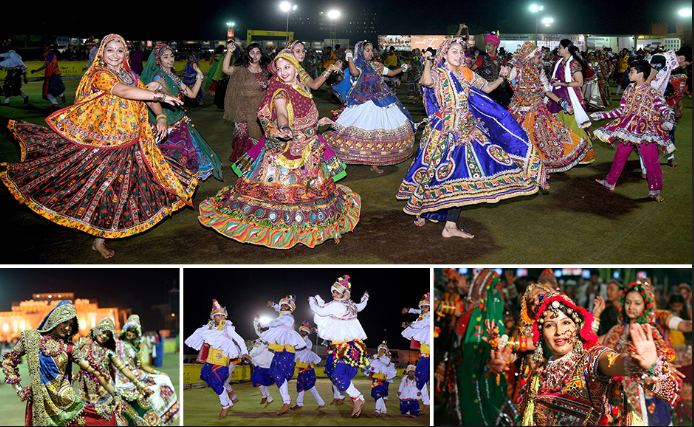In the last part of Gujarat blog, we understood about the Cultural, Geographical and Political aspects of Gujarat. If you haven’t read that already, click here – Know your State ” – Part 1. This part will be telling us about the Historical, Environmental and Economic aspects of Gujarat.
Do you know which state is home to Asiatic Lions in the world? Which state has the 3rd largest economy in India?
Gujarat has a special significance in Indian Political History as it is the birthplace of Mahatma Gandhi and his influence on the people of Gujarat with the Non-Violence Movement. So, let’s start with the very first aspect –
Table of Contents
HISTORY Gujrat GK Notes:
The history of Gujarat dates back to 2000 B.C. It is believed that Lord Krishna left Mathura to settle on the west coast of Saurashtra, which later came to be known as Dwarka, the gateway.
ANCIENT HISTORY
- In the Indus Valley Civilisation, Gujarat was one of the main central areas. The state contains ancient metropolitan cities from the Indus Valley Civilisation such as Lothal, Dholavira and Gola Dhoro.
- Lothal was the ancient city where India’s first port was established.
- Dholavira, one of the largest cities of Indus Valley Civilisation, was the most prominent archaeological sites in India.
- The most recent discovery was Gola Dhoro. Altogether, about 50 Indus Valley settlement ruins have been discovered in Gujarat.
- The recent history of Gujarat reflects the imperial grandeur of Chandragupta Maurya. The Mauryan Empire appointed Pushyagupta, a Vaishya, as the governor of Saurashtra. He ruled Girinagar (modern-day Junagadh) and built a dam on the Sudarshan Lake.
- The grandson of Chandragupta Maurya, Ashoka, not only ordered engraving of his edicts on the rock at Junagadh but also asked Governor Tusherpha to cut canals from the lake where an earlier Mauryan Governor had built a dam.
- For nearly 300 years, Saka rulers played a prominent part in Gujarat’s history. The weather-beaten rock at Junagadh gives a glimpse of the ruler Rudradaman I of the Saka Satraps known as Western Satraps or Kshatraps.
- The Kshtrapa dynasty was replaced by the Gupta Empire with the conquest of Gujarat by Chandragupta Vikramaditya.
- Several battles were fought in Gujarat between the South Indian Satvahana Dynasty and the Western Satraps.
- Gautamiputra Satkarni was the greatest and the mightiest ruler of Satvahana Dynasty who defeated the Western Satraps and conquered some parts of Gujarat in 2nd century A.D.
- When the Gupta Empire went into decline towards the middle of the 5th century, Senapati Bhatarka, the Maitraka general of the Gupta’s took advantage of the situation and set up what came to be known as the Maitraka state. He shifted his capital from Girinagar to Valabhipur, near Bhavnagar, on Saurashtra’s east coast.
- Gujarat was known to the ancient Greeks and was familiar with other western centres of civilisation through the end of the European Middle Ages.
MEDIEVAL HISTORY
- Medieval Gujarat saw the entry of the Muslim conquerors into India. The first of the Muslim conquerors were Mohammad of Ghazni.
- There were two small Muslim settlements in Cambay and Broach. The present name of Cambay and Broach is Khambat and Bharuch respectively.
- After the defeat of Karandev Vaghela against the military force of Allauddin Khilji, medieval Gujarat saw Muslim rule continuing for 400 years.
- When the Mughal Viceroy, Momin Khan, was defeated by the Marathas in 1758, the Muslim rule finally ended. The Marathas established their supremacy by snatching Ahmedabad from the Mughals in the same year.
- The Muslim period in medieval Gujarat is an interesting slice of history. Zafar Shah established the first Muslim Sultanate in Gujarat. He took advantage of the prevailing weak rulers of Delhi. He declared Independence and became the first Sultan. He assumed the title of Muzaffar Shah. His successor Ahmed Shah founded Ahmedabad city on the banks of the Sabarmati River.
- Ahmed Shah was succeeded by Mahmud Shah. Mahmud Shah was an able administrator. He successfully repulsed a Portuguese Naval attack and constructed a port on Diu.
- Chhatrapati Shivaji, the great Maratha ruler, who conquered Gujarat with his military skill, ended the Muslim rule in Medieval Gujarat.
- The Maratha rule was ended by the European colonial powers who made their contact with India at that time. The first European power to arrive in medieval Gujarat was the Portuguese.
MODERN HISTORY
- The history of modern Gujarat started with the advent of the Europeans in 1614 AD.
- The era of modern Gujarat first started when the Portuguese establishing several enclaves along the Gujarat coastline. The naval ports were also built by the Portuguese in the present-day Daman and Diu, Dadar and Nagar Haveli.
- The British East India Company founded its first base in India at Surat in 1614. This seemingly small commercial event eventually led the company to a dominant presence in India.
- The Indian Independence Movement was very active in Gujarat during the administration of the British Raj. The greatest of all Gujarati Indian freedom fighters was the great Mahatma Gandhi. He was joined in his noble task by other Gujarati Indian freedom fighters like Sardar Vallabhbhai Patel, Morarji Desai, KM Munshi, Narhari Parikh, Mahadev Desai, Mohanlal Pandya and Ravi Shankar Vyas.
- The Salt Satyagraha was led by Mahatma Gandhi. It was one of the most visible images of Gujarat during pre-independence days.
- Gujarat saw large post-independence turmoil. After independence, Gujarat was included under the old Bombay state. Bombay state had a Gujarati speaking north and a Marathi speaking south. Bombay state was finally demarcated into Gujarat and Maharashtra states. Modern Gujarat was thus formed with Ahmedabad as its capital.
- The capital was shifted from Ahmedabad to Gandhinagar in the year 1970. Gandhinagar is the present capital of modern Gujarat.
Gujarat is a maritime state having 1600 km long coastline, the longest in the country. It is rich with biodiversity of flora-fauna and natural resources. Natural gems are scattered throughout its lands along the coastal areas. Let’s take you to the aspect related to this –
ENVIRONMENT Gujrat GK Notes:
According to the India state of Forest Report 2011, Gujarat has 9.7% of its total geographical area under forest cover.
- As per the districts, the Dangs has the largest area under forest cover.
- Gujarat is the only home to Asiatic Lions and outside Africa, is the only present natural habitat of lions.
- There are total four (4) National Parks and Twenty-one (21) Wildlife Sanctuaries. Some of the important one’s are mentioned below:
- Gir National Park and Wildlife Sanctuary – This is also known as Sasan Gir. It is a forest and Wildlife Sanctuary near Talal Gir in Gujarat. It is a part of the Khathiar-Gir dry deciduous forest eco-region. It was established in 1965. The Park is very famous for Asiatic Lions.
- Nal Sarovar Bird Sanctuary – It consists primarily of a 120.22 sq.km lake and ambient marshes. It is situated about 64 km to the west of Ahmedabad near Sanand Village. Mainly inhabited by migratory birds in winter and spring, it is the largest wetland bird sanctuary in Gujarat, and one of the largest in India. It was declared a bird sanctuary in April 1969. The migratory bird population includes Rosy Pelicans, Flamingo, White Storks, Herons, etc.
- Marine National Park, Gulf of Kutch – It is located on the southern shore of the Gulf of Kutch in the Devbhumi Dwarka district of Gujarat state, India. In 1980, an area of 270 km2 from Okha to Jodiya was declared Marine Sanctuary. Later in, 1982, a core area of 110 sq.km was declared Marine National Park under the provisions of the Wildlife (Protection) Act, 1972 of India. There are 42 islands on the Jamnagar coast in the Marine National Park, most of them surrounded by reefs. The best-known island is known as Pirotan.
- Blackbuck National Park – Blackbuck National Park at Velvadar is situated in Bhavnagar district of Gujarat. It is established in 1976 in the Bhal region of Saurashtra. This is spread over an area of 34.08 sq.km and was primarily a “vidi” (grassland) of the Maharaja of the princely state of Bhavnagar for hunting the blackbucks with his famous hunting cheetahs. It has been classified as 4B Gujarat-Rajwadh biotic province of semi-arid bio-geographical zone.
- Kutch Great Indian Bustard Sanctuary or Kutch Bustard Sanctuary – It is also known as Lala-Parjan Sanctuary. This sanctuary is one of the two Great Indian Bustard Sanctuaries in Gujarat, the other one is in Jamnagar. This one is located near Jakhav village in Naliya Taheka, Abdasa district, Gujarat. It was declared as a sanctuary in 1992, specifically for the conservation of the Great Indian Bustard, the heaviest flying bird belonging to the avian family of Otididae.
- Other National Parks and Wildlife Sanctuary are Vansda National Park, Jambughoda National Park, Porbander Wildlife Sanctuary, Wild Ass Sanctuary, Narayan Sarovar Sanctuary, Jessore Sloth Bear Sanctuary, etc.
- Gujarat CM Vijay Rupani launched India’s first trading programme to combat particulate air pollution on World Environment Day 2019, which had air pollution as its theme. The programme is a market-based system where the government sets a cap on emissions and allows industries to buy and sell permits to stay below the cap. Being initiated in Surat by the Gujarat Pollution Control Board (GPCB), the Emission Trading Scheme (ETS) was designed with the help of a team of researchers from the Energy Policy Institute at the University of Chicago (EPIC), The Economic Growth Centre at Yale University and others from the Abdul Latif Jameel Poverty Action Lab (J-Pal).
- The major dams of the state are –
- Dantiwada Dam – It is a mud and masonry dam on the west Banas River near Dantiwada, Banaskanthan district of Northern Gujarat.
- Dholi Dam – Dholi Dam across the Madhumati River forms the Dholi reservoir in Jhagadia city, Gujarat.
- Dholidhaja Dam – It is across the Bhogavo River located near Surendranagar. Dudhrej Municipality in the state of Gujarat.
- Kamleshwar Dam – It is officially known as Hiran – I Dam, is a rock-filled embankment dam on the Hiran River in Visavadar, Gujarat.
- The state also has a biosphere reserve i.e. Great Rann of Kutch where the key fauna is Asiatic Lion, Blackbuck and Indian Wild ass.
Let’s come to the aspect which is responsible for the growth of the state –
ECONOMY Gujrat GK Notes:
The economy of Gujarat has significantly agriculture as well as industrial production within India. Major Agricultural produce of the state includes cotton, peanuts, dates, sugarcane, milk and milk products. Industrial products include cement and petrol.
- The economy of Gujarat is the third-largest in the country with a Gross State Domestic Product (GSDP) of Rs. 15.02 Lakh crore and has the country’s 11th highest GSDP per capita of Rs. 1,97,00.
- Gujarat ranks 21st among Indian states in the Human Development Index (HDI).
- In Gujarat, we have Kandla Port, which is a Tidal Port and this port was built after Partition as Karachi Port on the western side had gone to Pakistan. It is a major hub of imports such as Crude Oil, Chemicals, Textiles and Iron whereas Salt, Textiles and Grains are major exports from this port. It is one of the highest-earning ports in India.
- The state traditionally has low employment and is widely considered one of the most industrially developed states of India and a manufacturing hub.
- Reliance Industries operates the oil refinery at Jamnagar, which is the world’s largest grass-roots refinery at a single location.
- According to a 2009 report on economic freedom by the Cate Institute, Gujarat is the freest state in India (the second being Tamil Nadu).
- The world’s largest shipbreaking yard is in Gujarat near Bhavnagar at Alang.
- India’s only Liquid Chemical Port Terminal at Dahej, developed by Gujarat Chemical Port Terminal Company Limited.
- As of 2015, Gujarat ranks first nationwide in gas-based thermal electricity generation with a national market share of over 8% and second nationwide in Nuclear Electricity generation with a national market share of over 1%.
- Vadodra, near Mahi River, has a big Petrochemical Complex. Porbander is an important cement manufacturing centre and many chemical industries are located at this place.
EDUCATION Gujrat GK Notes:
There are several universities functioning in Gujarat that offers both undergraduate and postgraduate programs in various disciplines.
- Gujarat University is the oldest and the largest university in the state.
- Gujarat Forensic Sciences University (GFSU) is the first university in the world solely dedicated to forensic and investigative science.
- Entrepreneurship Development Institute of India (EDII), Ahmedabad is a leading management institute in grooming entrepreneurs and offering them master’s degree or fellowship in business entrepreneurship.
- Central Salt and Marine Chemicals Research Institute is another reputed operating in Gujarat and does various research works on inland lake salt, marine salt and sub-soil brine.
SPORTS:
Sports retain a very valuable position in the culture of Gujarat.
- Under the leadership of Shri Narendra Modi, the Prime Minister of India also the former Chief Minister of Gujarat, the initiative of “Khel Mahakumbh” (KMK), a mega sporting event was undertaken in the year 2010.
- Pro Kabaddi League is an initiative by Marshal Sports Pvt. Ltd and Star India Pvt. Ltd. It is backed by the Amateur Kabaddi Federation of India (AKFI), and supported by participating members of the International Kabaddi Federation (IKF) and the Asian Kabaddi Federation (AKF). The League is currently participated in by 12 teams, each split region-wise.
- The 6th Asian School Table Tennis Championship is scheduled to be held in Vadodra, Gujarat in August 2019. A total of eight countries including China, Bangladesh, Hong Kong, India, Indonesia, Nepal, Thailand and UAE are participating in the Championship.
Here are Some More Interesting Facts about Gujarat –
- The state encompasses some cities of the ancient Indus Valley Civilisation, such as Lothal, Dholavira and Gola Dhoro. Lothal is believed to be one of the India’s first seaports.
- Gujarat’s coastal cities such as Bharuch and Khambat, served as ports and trading centres in the Mauryan and Gupta Empire.
- Lord Krishna’s Abode, Dwarka is said to have existed more than 10,000 years ago and is believed to be the first capital of Gujarat. Today this coastal city is one of the “Char Dhams” (four religious seats) as per Hindu beliefs. Badrinath, Puri and Rameshwaram are the other three. The Dwarkadish Temple, dedicated to Lord Krishna was originally built around 2500 years back, but was destroyed by Mahmud Shah. It was later rebuilt in the 16th century.
- Asia’s greenest capital city is here i.e. Gandhinagar. It is located around 23 kms from Ahmedabad and is considered to be the greenest capital city in Asia with around ½ of its area covered greenery.
- UNESCO World Heritage Sites such as Champaner- Panagadh Archaeological Park: 2004 and Rani Ki Vav (2014) and historic city of Ahmedabad (2017). Rani Ki Vav is a heritage site that backed the title of cleanest iconic place in India at the Indian Sanitation Conference in 2016 in New Delhi.
- Nav Nirman Andolan – It is a socio-political movement of 1974 and this was the movement of students and middle-class people against corruption and economic crisis. This was the first and the last successful agitation after Independence of India that ousted the elected government.
- Gujarat is derived from the Sanskrit term Gurjaradesa, meaning “The Land of the Gurjaras (also called Gujjars)”, who ruled Gujarat in the 8th and 9th centuries CE. Parts of modern Rajasthan and Gujarat have been known as Gurjaratra or Gurjarabhumi (land of the Gujjars) for centuries before the Mughal period.
This was all about this state. We’ll keep informing you about the significance and beauty of each state/union territory just like this. In the next blog, we would be discussing some interesting facts and trivia about the state of Haryana. Click here for Know your State – ‘Haryana’. Hope this helps you in preparing for your competitive exams such as CDS, SSC CGL, NET JRF, etc.




